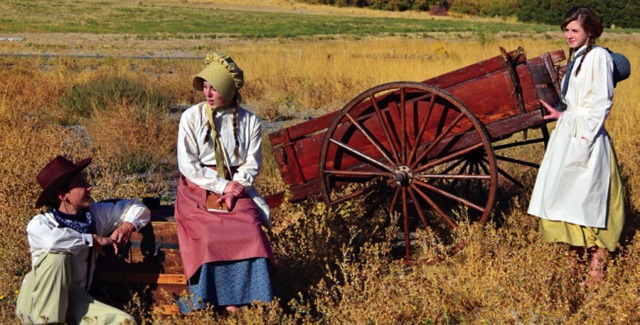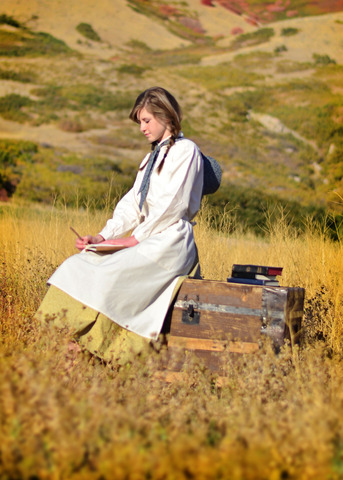 Pioneer Clothing
Pioneer Clothing
Part of the trek experience is wearing clothing that the pioneers would have worn. Dressing in pioneer clothing can have a tremendous impact on the spirit of the trek. Simple pioneer clothing will help draw a closer connection with the early pioneers.
In obtaining or making pioneer clothing, we encourage you to not spend excessive time or money. Many items can be found in existing wardrobes or at secondhand stores.
For simple clothing patterns to make your own clothes, check out this guide (Trek Clothing)
General Guidelines
Ideally, young women’s blouses should be lightweight and long-sleeved, and their skirts should reach the midcalf, with shorts or tights or capris underneath to prevent chafing. Lightweight, long-sleeved shirts and comfortable, loose-fitting pants are recommended for the young men. It is recommended that shorts or tights made of a wicking fabric be worn next to the skin.
You will need 2 outfits or changes and will get hot, sweaty and dirty on this Trek, so light-colored, breathable fabrics will work best. Historical exactness in the cut of your outfit is not necessary to the exact year, per se, but a close approximation is our aim.
Footwear
To help reduce the likelihood of blisters, you are encouraged to wear (1) walking or hiking shoes that are broken in and (2) two pairs of socks at a time. Ideally the inner sock is thin and synthetic, while the outer sock is wool or a wool blend. Socks that wick away moisture are the most helpful. Socks that are a wool-synthetic blend can also help reduce the potential for blisters.
Weather Protection
To help protect from sun and insects, participants are encouraged to wear long sleeves, wide-brimmed hats or bonnets, and sunglasses. There is also a high likelihood of rain during the trek so a rain jacket or poncho is recommended.
Men’s Clothing Descriptions
Shirts
Men’s shirts were worn loose. Plain colors were common, but stripes or plaids were also used. Light colors will be coolest. Choose something larger than a regular fit, with long sleeves.
Pants
Pants were also worn loose. Pants should be made of a lightweight, breathable fabric. Boys should also wear a wicking layer next to the skin to prevent chafing. Colors include blue, black, gray, browns, especially beige and tan. Choose rather loose fitting through the crotch and thigh area to add comfort In walking.
Suspenders
Men’s pants were held up by suspenders that were buttoned on the outside of the waistband, and crossed in the back.
Hats
Men’s everyday hats ranged from pilot caps, straw hats, wide brimmed low felt hats, or round crowned hat. No ball caps allowed.
Ties
Usually vests/ties were worn only on Sunday or when attending a meeting or social event. Ties were small, black and silky. Wrapped around the neck one and tied in the front with a square knot.
Womens Clothing Descriptions
Dresses
Women’s basic dresses were floor length. It could be plain or have many ruffles. The sleeves were full, and long, with buttons or bands at the wrist. Necklines were usually high, with buttons up the front. Fabrics were cotton in solid colors or small print. Bright colors were popular (especially bright yellow). Blouses and long skirts or jumpers could be used. Pioneer trekkers now have found that dresses and skirts should be mid-calf or above the top of a hiking boot in length (so the girls do not trip over their skirts while pulling).
Aprons
The standard apron was six to twelve inches shorter than the skirt length. It gathered at the waist and tied. The bib attached at the waist and was pinned to the dress bodice at the top two corners, hence, the name pinafore (Pinned at two of the four corners!). Daytime aprons were made of calico remnants. Sunday aprons were made from white fabric and did not have a bib. For trekking today, large deep pockets are important to be able to carry different items along the trail.
Bonnets / Hats
Women wore bonnets whenever they were outside. They were made of cotton with a deep stiffened brim and a back ruffle to protect the neck. They could be white, plain colors or a print, but they never matched the fabric of the dress. Today, bonnets or straw hats for the girls are important; they need to have something for protection from the sun.
Pantaloons / Bloomers
These were worn underneath the dress and were normally white. Their length was usually between knee and mid-calf. Modern day trekkers could use scrubs or pajama pants hemmed shorter. Wearing pantaloons is optional.

